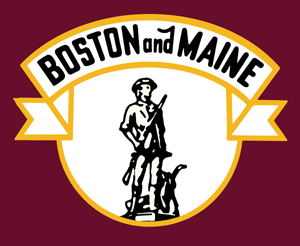
The Boston and Maine Railroad was a U.S. Class I railroad in northern New England. Originally chartered in 1835, it became part of what was the Pan Am Railways network in 1983.

The New York, New Haven and Hartford Railroad, commonly known as The Consolidated, or simply as the New Haven, was a railroad that operated in the New England region of the United States from 1872 to December 31, 1968. Founded by the merger of the New York and New Haven and Hartford and New Haven railroads, the company had near-total dominance of railroad traffic in Southern New England for the first half of the 20th century.

The St. Lawrence and Atlantic Railroad, known as St-Laurent et Atlantique Quebec in Canada, is a short-line railway operating between Portland, Maine, on the Atlantic Ocean, and Montreal, Quebec, on the St. Lawrence River. It crosses the Canada–US border at Norton, Vermont, and Stanhope, Quebec, and is owned by short-line operator Genesee & Wyoming.

The Flying Yankee was a diesel-electric streamliner built in 1935 for the Maine Central Railroad and the Boston and Maine Railroad by Budd Company and with mechanical and electrical equipment from Electro-Motive Corporation. It was also the name of a passenger train, the third streamliner train in North America. That train ceased passenger service in 1957 and is stored at the Hobo Railroad in New Hampshire and owned by the state of New Hampshire, which plans to open it to public viewing at some time in the future.

The Downeaster is a 145-mile (233 km) passenger train service operated by Amtrak and managed by the Northern New England Passenger Rail Authority (NNEPRA), an agency of the state of Maine. Named for the Down East region of Maine, the train operates five daily round trips between North Station in Boston, Massachusetts, and Brunswick, Maine, with 10 intermediate stops.

The Boston and Lowell Railroad was a railroad that operated in Massachusetts in the United States. It was one of the first railroads in North America and the first major one in the state. The line later operated as part of the Boston and Maine Railroad's Southern Division.

Sugarloaf is a ski area and resort located on Sugarloaf Mountain in Carrabassett Valley, western Maine. It is the second largest ski resort east of the Mississippi in terms of skiable area and snowmaking percentage (95%); its continuous vertical drop of 2,820 feet (860 m) is the second longest in New England. Sugarloaf recorded a total of 352,000 skier visits in the 2005–2006 season, ranking it second among Maine resorts and 11th in New England.

The Maine Central Railroad was a U. S. class 1 railroad in central and southern Maine. It was chartered in 1856 and began operations in 1862. By 1884, Maine Central was the longest railroad in New England. Maine Central had expanded to 1,358 miles (2,185 km) when the United States Railroad Administration assumed control in 1917. The main line extended from South Portland, Maine, east to the Canada–United States border with New Brunswick, and a Mountain Division extended west from Portland to St. Johnsbury, Vermont, and north into Quebec. The main line was double track from South Portland to Royal Junction, where it split into a "lower road" through Brunswick and Augusta and a "back road" through Lewiston, which converged at Waterville into single track to Bangor and points east. Branch lines served the industrial center of Rumford, a resort hotel on Moosehead Lake and coastal communities from Bath to Eastport.

The International Railway of Maine was a historic railroad constructed by the Canadian Pacific Railway (CPR) between Lac-Mégantic, Quebec, and Mattawamkeag, Maine, closing a key gap in the railway's transcontinental main line to the port of Saint John, New Brunswick.
The Kennebec Central Railroad was a 2 ft narrow gauge railroad operating between Randolph and Togus, Maine. The railroad was built to offer transportation for American Civil War veterans living at Togus to the nearby City of Gardiner. Tracks of 25-pound steel rails ran five miles from Randolph, Maine to the veterans home at Togus. Train service began on 23 July 1890.

The Plymouth & Lincoln Railroad is a class III shortline railroad operating on the Concord-Lincoln rail line in central New Hampshire, United States. The railroad consists of two distinct passenger operations, the Hobo Railroad, which offers passenger excursion trains in the White Mountains, and the Winnipesaukee Scenic Railroad, which operates passenger excursion trains along the shore of Lake Winnipesaukee in the Lakes Region of New Hampshire. In addition to passenger operations, the railroad owns the Lincoln Shops, a railroad equipment maintenance and repair facility located in Lincoln, New Hampshire.
Leslie B. "Les" Otten is the former CEO of the American Skiing Company. Since resigning as its chief executive officer in 2001, Otten has been involved in numerous other businesses and industries, including the Major League Baseball's Boston Red Sox.

The New England Southern Railroad is a Class III shortline railroad that operates out of Canterbury, New Hampshire, and serves industries in central New Hampshire, in the United States.

The railroad history of Portland, Maine, began in 1842 with the arrival of the Portland, Saco & Portsmouth Railway (PS&P). Most of the rail activity in Portland revolved around agricultural goods bound for export and import freight from Europe. Yet Maine's largest city also enjoyed 125 years of continuous passenger rail service, from 1842 until 1967, and Amtrak began serving the city in 2001. For most of Portland's history, passenger train schedules were designed with intercity travel rather than daily commuting in mind; passenger activities were mostly confined to intercity travel from Portland to Boston, Montreal, Nova Scotia, and points west.

Portland Transportation Center is a bus and train station in Portland, Maine, United States, served and run primarily by Concord Coach Lines and Amtrak Downeaster passenger trains. It is also served by Megabus, as well as the Greater Portland Metro Bus Route 1 BREEZ express bus service to Brunswick, Maine. The station is open from 4:30 AM to 12:15 AM and from 2:45 AM to 3:15 AM.

The Eastern Railroad was a railroad connecting Boston, Massachusetts to Portland, Maine. Throughout its history, it competed with the Boston and Maine Railroad for service between the two cities, until the Boston & Maine put an end to the competition by leasing the Eastern in December 1884. Much of the railroad's main line in Massachusetts is used by the MBTA's Newburyport/Rockport commuter rail line, and some unused parts of its right-of-way have been converted to rail trails.

The Mountain Division is a railroad line that was once owned and operated by the Maine Central Railroad (MEC). It stretches from Portland, Maine on the Atlantic Ocean, through the Western Maine Mountains and White Mountains of New Hampshire, ending at St. Johnsbury, Vermont in the Northeast Kingdom. The line was abandoned in 1983 by MEC's successor, Guilford Transportation Industries (GTI). Guilford retained a stub between Portland and Westbrook. A section in New Hampshire remains in use by heritage railway Conway Scenic Railroad.
A ski train is a passenger train which is marketed to carry passengers to ski resorts. A ski train may only operate during the winter sports season, or it may operate more frequently and have extra capacity during the winter sports season.

The Stony Brook Railroad, chartered in 1845, was a railroad company in Massachusetts, United States. The company constructed a rail line between the Nashua and Lowell Railroad's main line at the village of North Chelmsford and the town of Ayer, Massachusetts where it connected to the Fitchburg Railroad. Rather than running its own trains, upon opening in 1848 operations were contracted to the Nashua and Lowell; this arrangement continued until the Nashua and Lowell was leased by the Boston and Lowell Railroad in 1880. The Boston and Maine Railroad (B&M) took over operation of the Stony Brook in 1887 when it leased the Boston and Lowell Railroad. In 1983 the B&M was purchased by Guilford Rail System, which renamed itself Pan Am Railways (PAR) in 2006. Passenger service last ran on the line in 1961, but it saw significant freight service under Pan Am Railways. While it never owned rolling stock or ran trains, the Stony Brook Railroad Corporation existed until 2022 as a nearly wholly owned subsidiary of the Boston and Maine, itself a PAR subsidiary. That year, it was merged into CSX Transportation as part of CSX's purchase of Pan Am Railways.
The State of Maine was an overnight passenger train between New York City and Portland, Maine, that was operated jointly for more than 50 years by the Boston and Maine Railroad and the New York, New Haven and Hartford Railroad. It departed New York's Pennsylvania Station at 9:00 p.m. and arrived at 6:45 a.m. at Portland's Union Station, where connections were available on Maine Central Railroad trains to most Maine locations. It ended service in October 1960, the last direct passenger rail service between New Hampshire or Maine and New York City.
















